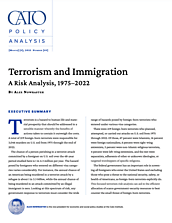The chance of a person perishing in a terrorist attack committed by a foreigner on U.S. soil over the 48-year period studied here is 1 in 4.3 million per year. The hazard posed by foreigners who entered on different visa categories varies considerably. For instance, the annual chance of an American being murdered in a terrorist attack by a refugee is about 1 in 3.3 billion, while the annual chance of being murdered in an attack committed by an illegal immigrant is zero. Looking at this spectrum of risk, any government response to terrorism must consider the wide range of hazards posed by foreign-born terrorists who entered under various visa categories.
There were 219 foreign-born terrorists who planned, attempted, or carried out attacks on U.S. soil from 1975 through 2022. Of those, 67 percent were Islamists, 16 percent were foreign nationalists, 6 percent were right-wing extremists, 5 percent were non-Islamic religious terrorists, 4 percent were left-wing extremists, and the rest were separatists, adherents of other or unknown ideologies, or targeted worshippers of specific religions.
The federal government has an important role in screening all foreigners who enter the United States and excluding those who pose a threat to the national security, safety, or health of Americans, as foreign-born terrorists explicitly do. This focused terrorism risk analysis can aid in the efficient allocation of scarce government-security resources to best counter the small threat of foreign-born terrorists.



